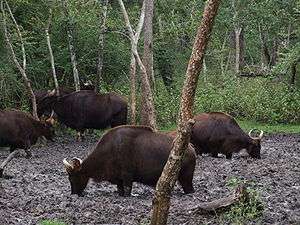Mineral lick

A mineral lick (also known as a salt lick) is a place where animals can go to lick essential mineral nutrients from a deposit of salts and other minerals. Mineral licks can be naturally occurring (natural licks) or artificial (such as blocks of salt that farmers place in pastures for livestock to lick). Natural licks are common, and they provide the biometals (sodium, calcium, iron, phosphorus, zinc, and trace elements) required in the springtime for bone, muscle and other growth in deer and other wildlife, such as moose, elephants, tapirs, cattle, woodchucks, domestic sheep, fox squirrels, mountain goats and porcupines. Such licks are especially important in ecosystems with poor general availability of nutrients. Harsh weather exposes salty mineral deposits that draw animals from miles away for a taste of needed nutrients. It is thought that certain fauna can detect calcium in salt licks.[1]
Overview
Many animals regularly visit mineral licks to consume clay, supplementing their diet with nutrients and minerals. Some animals require the minerals at these sites not for nutrition, but to ward off the effects of secondary compounds that are included in the arsenal of plant defences against herbivory.[2] The mineral contents of these sites usually contain calcium (Ca), magnesium (Mg), sulfur (S) phosphorus (P), potassium (K), and sodium (Na).[3][4][5][6] Mineral lick sites play a critical role in the ecology and diversity of organisms that visit these sites, but little is still understood about the dietary benefits. "The adjectives ‘mineral’ and ‘salt’ bear witness to the common proposition, in the ecological literature, that animals eat soil to satisfy a craving for nutrient minerals, resulting from inadequate forage. However, for wild animals that frequent licks, sodium is the only mineral identified so far, with strong evidence that an extra supply is indeed needed and sought in some cases."[7]:107
Nonetheless, many studies have identified other uses and nutritional benefits from other micronutrients that exist at these sites, including selenium (Se), cobalt (Co) and/or molybdenum (Mo).[8][9] In addition to the utilization of mineral licks, many animals suffer from traffic collisions as they gather to lick salts accumulated on road surfaces. Animals also consume soil (geophagy) to obtain minerals, such as moose from Canada mining for minerals from the root wads of fallen trees.[10][11]
Artificial salt licks
People use salt licks in the husbandry of livestock and to attract or maintain wildlife, whether it be for viewing, photography, farming, or hunting purposes. Maintaining artificial salt licks as a form of baiting is illegal in some states in the United States, but legal in others.[6]:413
In American history
The indigenous people of America and the Long Hunters watched salt licks to hunt game. Many became well known including Bledsoe lick in Sumner County, Tennessee, the Blue lick in central Kentucky, the French lick in southern Indiana, and the Blackwater lick.[12]
Mythology
In Norse mythology, before the creation of the world, it was the divine cow Audhumla who, through her licking of the cosmic salt ice, gave form to Buri, ancestor of the gods and grandfather of Odin. On the first day as Audhumla licked, Buri's hair appeared from the ice, on the second day his head and on the third his body.[13]
See also
References
- ↑ C. Michael Hogan. 2010. Calcium. eds. A.Jorgensen, C.Cleveland. Encyclopedia of Earth. National Council for Science and the Environment.
- ↑ Voigt, C. C.; Capps, K. A.; Dechmann, D. K. N.; Michner, R. H.; Kunz, T. H. (2008). "Nutrition or detoxification: Why bats visit mineral licks of the Amazonian rainforest". PLoS ONE. 3 (4): e2011. doi:10.1371/journal.pone.0002011.
- ↑ Emmons, L. H.; Stark, N. M. (1979). "Elemental composition of a natural mineral lick in Amazonia". Biotropica. 11 (4): 311–313. doi:10.2307/2387925. JSTOR 2387925.
- ↑ Black, J. G.; Mosquera, D.; Guerra, J.; Loiselle, B. A.; Romo, D.; Swing, K. (2011). "Mineral licks as diversity hotspots in lowland forest of eastern Ecuador". Diversity. 3 (2): 217–234. doi:10.3390/d3020217.
- ↑ Ayotte, J. B.; Parker, K. L.; Gillingham, M. P. (2008). "Use of natural licks by four species of ungulates in northern British Columbia". Journal of Mammalogy. 89 (4): 1041–1050. doi:10.1644/07-MAMM-A-345.1.
- 1 2 Atwood, T. C.; Weeks, H. P. (2003). "Sex-specific patterns of mineral lick preference in white-tailed deer". Northeastern Naturalist. 10 (4): 409–414. doi:10.2307/3858657. JSTOR 3858657.
- ↑ Kreulen, D. A. "Lick use by large herbivores: A review of benefits and banes of soil consumption". Mammal Rev. 15 (3): 107–123. doi:10.1111/j.1365-2907.1985.tb00391.x.
- ↑ Mills, A.; Milewski, A. (2007). "Geophagy and nutrient supplementation in the Ngorongoro Conservation Area, Tanzania, with particular reference to selenium, cobalt and molybdenum". Journal of Zoology. 271 (1): 110–118. doi:10.1111/j.1469-7998.2006.00241.x.
- ↑ Ayotte, J. B.; Parker, K. L.; Arocena, J. M.; Gillingham, M. P. (2006). "Chemical composition of lick soils: Functions of soil ingestion by four ungulate species". Journal of Mammalogy. 87 (5): 878–888. doi:10.1644/06-MAMM-A-055R1.1.
- ↑ Rea, R. "Mining and geophagy of root wad soils by moose in winter" (PDF). Wildlife Afield. 4 (1): 86–87.
- ↑ Klassen, N. A.; Rea, R. V. (2008). "What do we know about nocturnal activity of moose?". Alces. 44: 101–109.
- ↑
- ↑ Prose Edda by Snorri Sturluson
Further reading
| Wikimedia Commons has media related to Salt licks. |
- Kurlansky, Mark (2002). Salt: A World History.Walker and Co. ISBN 0-8027-1373-4.

